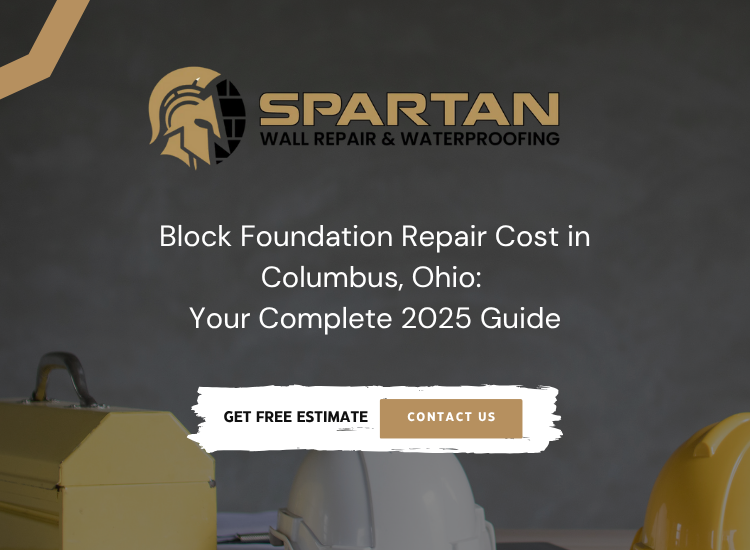Understanding Post-Waterproofing Mold Risks
Even after professional waterproofing, your Columbus basement remains vulnerable to mold if proper prevention measures aren’t implemented. Mold thrives in damp, dark environments. The fungus feeds on organic materials commonly found in basements, including wood framing, drywall, cardboard storage boxes, and certain types of insulation.
Mold only needs 20% moisture to grow. This sobering fact means that even minor humidity issues can lead to mold problems. If you see mold, mildew, or smell a musty odor, chances are that’s only 10% of the total mold in your basement!
In Columbus, Ohio’s climate, with its humid summers and wet springs, creates additional challenges. The region’s clay soil retains moisture, and temperature fluctuations can cause condensation issues even in waterproofed basements. the jail in Columbus, OH, still sees mold outbreaks regularly, demonstrating that even commercial buildings struggle with mold prevention in our local climate.
Essential Mold Prevention Steps After Waterproofing
1. Install and Maintain Proper Dehumidification
Maintaining humidity levels between 40 and 50 percent is crucial for a safe and healthy home. After waterproofing, installing a high-quality dehumidifier is your first line of defense against mold growth.
Professional-grade basement dehumidifiers offer several advantages:
- Continuous moisture removal
- Air purification capabilities
- Automatic humidity control
- Energy-efficient operation
A dehumidifier helps keep your basement dry. Depending on the size and type, they cost $50 to $1,000. For Columbus homes, we recommend investing in a unit rated for your basement’s square footage that can handle our region’s humidity levels.
2. Ensure Proper Ventilation
Good air circulation prevents moisture buildup and reduces mold spore concentration. After waterproofing:
- Keep basement windows cracked open during dry weather
- Install exhaust fans in basement bathrooms
- Avoid blocking air vents with storage
- Consider adding a ventilation system if natural airflow is limited
3. Regular Moisture Monitoring
Even with waterproofing, vigilance is key:
- Check humidity levels weekly with a hygrometer
- Inspect walls and floors monthly for signs of moisture
- Look for condensation on pipes and windows
- Monitor areas around basement windows and doors
4. Strategic Storage Solutions
Proper storage prevents mold growth on your belongings:
- Use plastic bins instead of cardboard boxes
- Keep items elevated on shelves or pallets
- Maintain space between stored items and walls
- Avoid storing organic materials like papers or fabrics directly on concrete
5. Address Condensation Issues
Columbus’s temperature swings can cause condensation problems:
- Insulate cold water pipes
- Install vapor barriers where recommended
- Use waterproof insulation on exterior walls
- Seal air leaks that allow humid outdoor air inside
Cost Breakdown for Mold Prevention Measures
Understanding the investment required for comprehensive mold prevention helps Columbus homeowners budget effectively:
Dehumidification Systems
- Basic portable units: $200-$500
- Professional-grade systems: $1,100-$2,800
- Installation (if required): $300-$500
Air Quality Solutions
- HEPA air purifiers: $150-$600
- UV light systems: $500-$1,500
- Ventilation improvements: $500-$2,000
Moisture Barriers and Sealants
- A vapor barrier is a unique membrane available for basements and crawl spaces, costing between $0.50 and $0.70 per sq.ft. installed.
- Interior sealants: $3-$7 per square foot
- Crack repairs: $250-$800 for minor issues
Professional Mold Remediation (if needed)
- If the problem is extensive, you may need mold remediation. Mold removal costs $1,500–$4,000
- Mold remediation costs between $500 and $3,500.
What Affects Mold Prevention Success
Several factors influence how well your mold prevention efforts work in Columbus:
Soil Conditions
Columbus’s clay soil expands when wet and contracts when dry, potentially creating new entry points for moisture. This makes ongoing prevention crucial even after waterproofing.
Home Age and Construction
- Homes built before 1960 often lack proper vapor barriers
- Older foundations may develop new cracks over time
- Original construction methods may not meet modern moisture control standards
Basement Usage
Finished basements require more aggressive mold prevention:
- Additional dehumidification for living spaces
- Moisture-resistant materials for finishing
- Regular HVAC maintenance to prevent condensation
Seasonal Factors
Columbus experiences:
- High humidity in summer (requiring stronger dehumidification)
- Freeze-thaw cycles in winter (potentially creating new cracks)
- Heavy spring rains (testing waterproofing systems)
DIY vs. Professional Mold Prevention
What Homeowners Can Do Themselves
Many mold prevention tasks are suitable for DIY:
- Installing and maintaining portable dehumidifiers
- Regular cleaning and inspection
- Improving storage practices
- Basic ventilation improvements
- Applying waterproof paint to interior walls ($1-$2 per square foot)
When to Call Professionals
DIY solutions often address only surface issues, neglecting underlying moisture problems. Professional help is essential for:
- Installing whole-home dehumidification systems
- Complex ventilation solutions
- Vapor barrier installation
- Any signs of active mold growth
- Annual waterproofing system inspections
Why Mold Prevention Is Worth the Investment
Protecting Your Home’s Value
Mold issues can significantly impact your property value. Not only will the presence of mold in your home compromise your health, but it can severely damage the market value of your home. Proper prevention maintains and even increases your home’s worth.
Health Benefits
Mold can present a clear danger to the health and wellbeing of your family. Prevention protects against:
- Respiratory issues
- Allergic reactions
- Asthma exacerbation
- Cold and flu-like symptoms
Cost Savings
Preventing mold is far more economical than remediation:
- Prevention: $500-$3,000 for comprehensive measures
- Remediation: $1,500-$6,000 or more
- Structural repairs from mold damage: Potentially tens of thousands
Peace of Mind
Knowing your basement is protected allows you to:
- Safely use the space for storage or living
- Avoid emergency remediation costs
- Protect your family’s health
- Maintain your home’s structural integrity
Regional Considerations for Columbus, Ohio
Local Climate Challenges
Columbus experiences unique moisture challenges:
- Average annual precipitation: 39 inches
- High summer humidity levels (often above 70%)
- Frequent temperature swings causing condensation
- Clay soil that retains moisture
Columbus Building Codes
Local regulations require:
- Proper ventilation in finished basements
- Egress windows meeting specific standards
- Permits for major waterproofing modifications
- Compliance with Ohio Building Code for moisture control
Comparison with Other Regions
While mold prevention costs in Columbus align with national averages, our specific challenges differ from other areas:
- Unlike arid regions, we can’t rely on natural dry conditions
- Compared to coastal areas, we have less salt air corrosion but more freeze-thaw issues
- Our clay soil creates unique hydrostatic pressure challenges
FAQ – Basement Mold Prevention After Waterproofing
How do I know if I need additional mold prevention after waterproofing?
If you notice musty odors, see condensation on walls or pipes, or measure humidity levels above 50%, you need additional prevention measures. Columbus’s humid climate means most waterproofed basements still benefit from active dehumidification and proper ventilation.
Is mold prevention covered by homeowner’s insurance?
Most insurance policies don’t cover mold prevention or remediation unless it results from a covered peril like sudden pipe burst. However, prevention measures may qualify for home improvement tax credits. Check with your insurance provider for specific coverage details.
How long does mold prevention equipment last?
Quality dehumidifiers typically last 8-10 years with proper maintenance. Vapor barriers can last 20+ years if properly installed. Air purifiers need filter replacements every 6-12 months but can last many years. Regular maintenance extends equipment life significantly.
Can I prevent mold with waterproof paint alone?
The cheapest basement water proofing method is water proof paint, which typically costs just $1 to $2 per square foot. However, paint alone isn’t sufficient for mold prevention in Columbus’s climate. It should be combined with proper dehumidification and ventilation.
What’s the cheapest way to prevent basement mold?
The most economical approach combines DIY monitoring (using a $20 hygrometer), strategic use of fans for air circulation, proper storage practices, and a basic dehumidifier ($200-$500). However, skipping professional-grade solutions may cost more long-term if mold develops.
Protect Your Columbus Home with SpartanWallRepair.com
Don’t let mold compromise your basement waterproofing investment. At Spartan Wall Repair, we understand Columbus’s unique challenges and provide comprehensive mold prevention solutions tailored to local conditions. Our experienced team has protected hundreds of Central Ohio homes with proven prevention strategies that work.
Contact us today for a free, no-obligation inspection. We’ll assess your waterproofed basement, identify potential mold risks, and create a customized prevention plan that fits your budget. With transparent pricing, local expertise, and a commitment to keeping Columbus homes healthy and dry, Spartan Wall Repair is your trusted partner in basement mold prevention.
Call now to schedule your free consultation and protect your family’s health and your home’s value. Because in Columbus, Ohio, successful mold prevention requires local knowledge and professional expertise.




